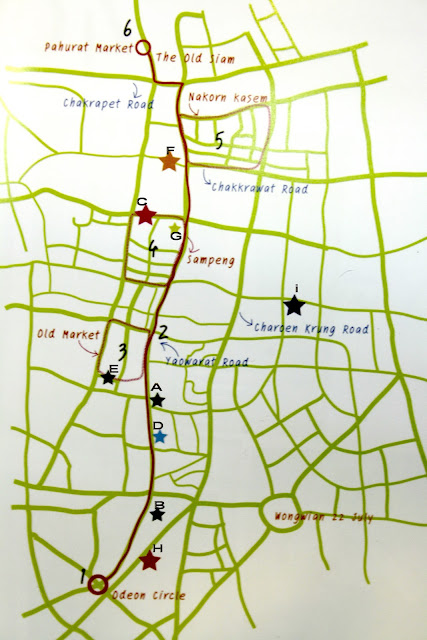Before you go
The very best approach to Chinatown, even before you open a map, is to OPEN your mind to an alternative shopping reality. This is a reality where, not only is it OK to get lost, it is probably ideal - who knows what treasure you might find around that next bend.
So open your mind; grab your water bottle; put your purse where it won't be picked; comfy shoes; loose clothes....it will be worth it.
1 Starting Point: The Ceremonial Gate at Odeon Circle |
As Confucius said, a journey of a thousand miles begins with a single step. It is good to have a starting point but go armed with the knowledge that it is a shopping 'experience'. There is so much to see and absorb just by wandering around, so don't worry if you get 'off track'.
2 Yaowarat Road |
A short walk up from Odeon Circle will bring you to many street stalls selling all things Chinese: lucky charms woven from red and gold satin; amulets carved from jade, and Oriental clothing of all descriptions - cheongsams,qipaoo and hats for young and old. There are traditional medicine shops to wonder at, and if you maintain your appetite, some well patronised delicious smelling noodle and dumpling shops too. Indeed, in the evening, Yaowarat Road transforms into an al fresco stall-street market, brimming over with Chinese treats. Yaowarat Road is called 'Golden Road' because there are more than 130 gold shops running along each side. This makes Chinatown Thailand's largest gold trading centre. Tang Toh Kang, who specialises in hand-crafted jewellery, is the oldest existing gold trader in Bangkok (since 1880).
3 Talad Kao (Old Market) |
From fresh to preserved food products, Talad Kao has been Chinatown's marketplace for well over a hundred years. Chinese chefs from restaurants around Bangkok come here each morning to find the best ingredients. If you are not a Chinese chef though, the variety may seem strange, mysterious and exciting. For the brave, nearby restaurants sell dishes with the ingredients that are found here.
4 Sampeng Lane (Wanit 1 Road) |
Turn left from Yaowarat Road (you will see an ornate signpost directing you). Stepping into Sampeng is entering a lane that time forgot. As unbelievable as it seems today, this hairbreadth wide lane was once Chinatown's main street. The crowded and bustling alley hosts stockladen motorbikes; caterwauling deliverymen lugging heavy carts; antique beggars and stoic shoppers all competing for that one square metre of lane.
Although Sampeng seems at first glance to be an overwhelming melange of everything from buttons to pool toys, the long alley can be roughly divided into three areas. Coming from the direction of the Odeon, the first section sells mostly inexpensive home items - plastic containers, pots, hairclips, flip-flops and party supplies. Leading up to Ratchawong Road, you will find stationery,exotic paper, crafts, toys, jewellery, and imitation bags and flowers. Cross over Ratchawong Road to find haberdashery, fabric, feathers, buttons and a myriad of glistening paraphernalia.
Special Mention : Sampeng Lane is the place to come at Cristmas, Chinese New Year and Halloween for decorations. Shops are open daily from 8.00am-9.00pm.
5 Thieves' Market (Nakorn Kasem) |
A small market running between Charoen Krung (New Road) and Yaowarat Road. By all accounts, it's 'not as good as it used to be' (presumably when it actually traded stolen goods), but these days focuses on an interesting selection of second-hand goods, electronics, uniforms, musical instruments and the odd cement mixer.
Opening hours: 8.00am-5.00pm.
6 Little India, Pahurat Market |
At the end of Sampeng Lane, cross over Chakrapet Road to the Pahurat cloth market. Don't stay on the main road; take a deep breath and wander into almost-not-there entrances which take you into a labyrinthine world of textiles (silk, cotton, cashmere and wool); and national costumes (Thai, Indian and Korean); as well as Indian God statuettes, incense and food supplies.
From map above,
Eat suggestion
A: Seafood from the grilled fresh seafood stalls (which are open at nigth)
B: Chalerm Buri Shark Fin, famous for its shark fin soup and fried goat's meat. Open daily 11.00am-10.30pm, Tel +66(0)2222 3029
C: Pad Thai Kikuya, cooked on the stove and wrapped in a banana leaf if you order to take home. Open Tue-Sat 6.30pm-10.00pm. Tel +66(0)8 1253 5961
Drink suggestion
D: Cotton Jazz Bar at Shanghai Mansion, a jazz bar designed in a romantic 1930's Shanghai style. Open daily from 6.30pm-10.30pm. Tel +66(0) 2221 2121
E: Eiah-Sae, a coffee shop which has been open for over 80 years. Open daily 5.00am-10.00pm. Tel +66(0) 2221 0549
Shop suggestion
F: Chao Krom Per, a traditional Chinese herb shop which has been open for over 100 years. Open Mon-Sat 8.30am-4.30pm Tel +66(0) 2221 3272
G: Tang Toh Kang, the first gold shop on Yaowarat area with a gold museum on 6th floor. Open daily 9.30am-4.00pm Tel +66(0) 2225 2898, or (0) 2224 2422 (reservation for museum)
Temple suggestion
H: Wat Trai-mitr, a temple in which the biggest golden buddha image in the world is situated. http://www.wattraimitr-withayaram.com/
I: Wat Mungkorn Kamalawat, a famous Chinese temple also known as Leng Noei Yi. http://www.lengnoeiyi.com/

The photo of the bunches of roses was taken by me and is used here without permission or acknowledgement. Visit http://hellonearth-livinginasia.blogspot.com for many more interesting photos, mainly of South East Asia. Please use my blog address as acknowledgement if using my photos in theis way.
ReplyDelete